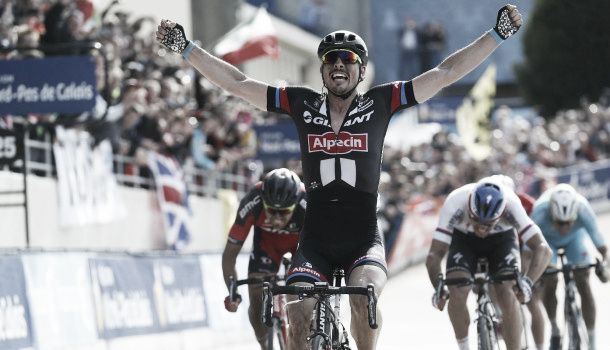John Degenkolb (Giant-Alpecin) rode a perfect race and won the 2015 edition of Paris-Roubaix, out-sprinting Zdenek Stybar (Etixx-QuickStep) and Greg Van Avermaet (BMC) to take the win.
In the process he became only the second-ever German to win the race after Josef Fischer, who won the first edition of the race in 1896.
The race was delayed by 12 minutes and started at 10:42. With a strong tailwind, forming the day's breakaway was a tough task. 20 kilometres into the race, a group of 10 riders - Gregory Rast (Trek Factory Racing), Adam Blythe (Orica-GreenEdge), Alexis Gougeard (Ag2r-La Mondiale), Aleksejs Saramotins (IAM Cycling), Pierre-Luc Perichon (Bretagne-Seche), Tim Declercq (Topsport-Vlaanderen), Sean De Bie (Lotto-Soudal) Frederik Backaert (Wanty Groupe Gobert) and Ralf Matzka (Bora Argon 18) finally escaped and formed the day's breakaway.
With sunny and dry weather, the peloton took a relaxed approach and the break had a gap of nine minutes when they entered the first cobbled sector at Troisvilles à Inchy.
Team Sky and Etixx-QuickStep, who were eager to protect their leaders, took up the responsibility of setting the pace at the front.
In the second sector, Stijn Devolder and Gert Steegmans of Trek hit the deck hard and abandoned the race.
Team Sky leader and one of the favourites of the race Geraint Thomas did not have lady luck on his side today. He punctured less than 3 kilometres from the fabled Arenberg sector and crashed hard later on with 80 kilometres to go. Despite a hard effort, he was unable to catch the peloton.
With 70 kilometres to go, Etixx-QuickStep hit the front and took advantage of the crosswinds. Race favourite Alexander Kristoff (Katusha) was caught in the chasing group and crowd favourite Bradley Wiggins (Sky) found himself in the third group on the road. FDJ, who were looking after their sprinter Arnaud Demare, took up the reins and brought the bunch back together.
Stijn Vandenbergh (Etixx-QuickStep) and Jens Debusschere (Lotto-Soudal) attacked on two separate occasions inside 40 kilometres, but they were never given more than 15 seconds of leg room by the ever-cautious peloton, which was now reduced to 40 riders.
At sector seven in Templeuve, Wigins attacked to bridge up to Vandenbergh and was joined by Debusschere and Stybar. Despite having the firepower, there was a lack of co-ordination among the four and were brought by a chase led by Wanty and Katusha.
The four-starred Carrefour de l'Arbre sector reduced the front bunch to less than 20 riders with 14km to go, and exiting the section Lars Boom (Astana) attacked.
A counter attack went up the road with Yves Lampaert (Etixx-QuickStep) and Greg Van Avermaet (BMC). Without a co-ordinated chase effort, this looked the move of the day with ten kilometres remaining including one two-starred cobble section.
With nine kilometres to go, Degenkolb attacked. He found some assisatnce from teammate De Backer who was stuck in the No-man's land. He entered the final cobbled section alone at Willems à Hem sector and bridged to the duo upfront at the exit.
In an interview the day before the race, Degenkolb mentioned his ideal scenario as, entering the velodrome in a small bunch and sprinting to the line. Despite Lampaert not working in the trio, "Dege" did not panic and set the pace at the front assisted by Van Avermaet.
With three kilometres remaining, Stybar bridged to the trio dragging alon Jens Keukeleire (Orica-GreenEdge), Martin Elmiger (IAM) and Lars Boom (Astana).
The seven riders entered the peloton with a sizeable gap over the rest of the field. Interestingly, this was the first time since 1997 that more than four riders have entered the Velodrome in the front bunch
Although Lampaert gave Stybar a proper leadout, Degenkolb had the superior legs and experience to outkick him with 200 metres to go to take the win.
“This is the race I’ve always dreamt of winning,” Degenkolb said before hugging his teammates at the finish.
“This is unbelievable. I can’t believe it, right now. I’ve had to work very hard for it and my team was there the whole day to hold the situation under control, until I could start my race. We knew that it was going to be hard and that a big group could go to the finish. I was in a situation that I had to go, otherwise I’d be in the same situation as last year [when he finished second behind lone winner Terpstra]. I had to invest something and I was not afraid to fail. That was the key.
“When you are probably the fastest guy, nobody wants to work with you and bring you to the finish. That’s why I decided to go by myself. I think it was the right decision and at the right moment. It was really, really hard but I’m just so happy and proud.”









































